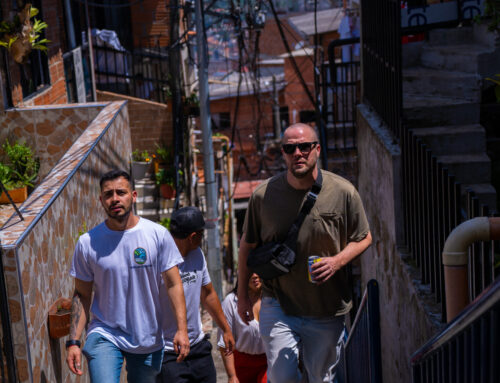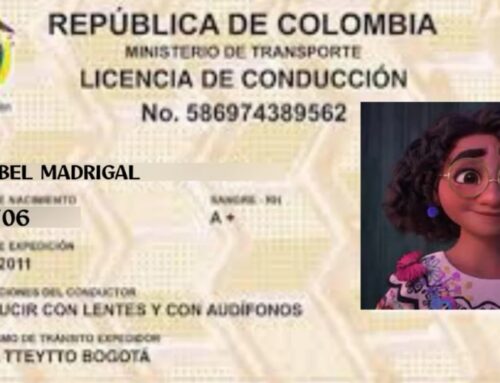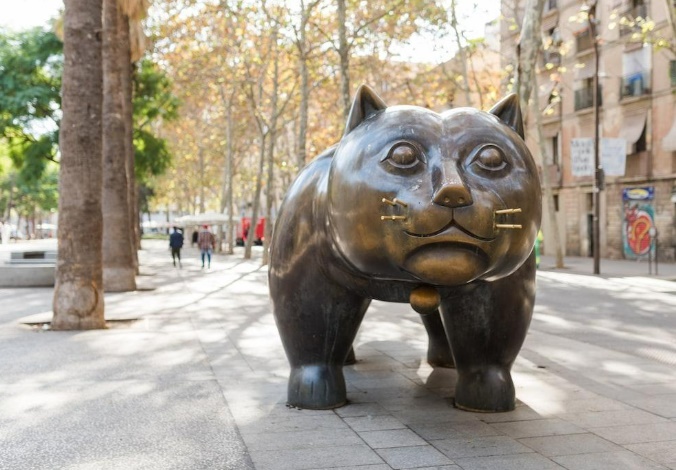
Colombia is a country that’s full of contrast and color. It’s currently a popular tourist destination, but only a few decades ago it was known for containing some of the most dangerous cities in the world. It has some of the most advanced medical centers in Latin America, but a large portion of its population also lives below the poverty line. Colombia’s history has been marked by violence and injustice, as well as hope and transformation. It’s possible to see these patterns in the works of the country’s most famous artists as well – powerful themes, strong colors, and messages that can’t be ignored.
There are many famous artists with work on display at various Medellin Museum Tours
Some of the artists discussed below, such as Fernando Botero, still have a lot of their work displayed in Colombia. The Plaza de Botero alone has 23 of his statues, which he donated to the city of Medellin; the museum of Antioquia has more statues and quite a few paintings as well. The works of Botero can be seen in different museums throughout Medellin, as well as in some parks. Medellin museum tours are recommended for anyone who’s interested in knowing the background of these culturally significant works, but it’s also possible to find and enjoy them on their own.
As for the other artists mentioned here, some of them have taken their work abroad. Even so, their influence on Colombian art remains strong, just as the country has strongly influenced them.
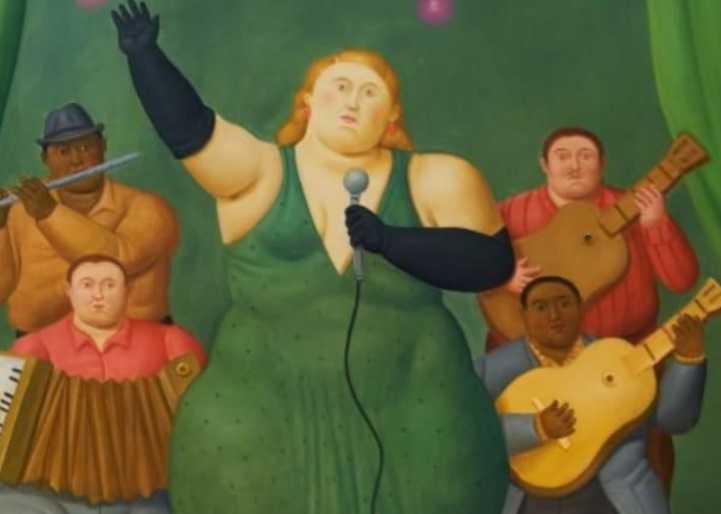
Fernando Botero
It’s impossible to bring up Colombian artists without talking about Fernando Botero. He’s easily the most well-known artist in Colombia, and maybe even the most famous artist in Latin America. Because he took a diverse approach in presenting his artwork, it quickly spread across the globe. Of course, it also helps that he’s been very generous in donating his works to cities and organizations around the globe.
One reason why Botero is so respected is that his talent is so varied. He’s most recognized for his portrayals of daily life in Colombia, personal portraits, or female nudes. However, he didn’t shy away from depicting Colombia’s problems with criminal violence, or other overtly political subjects. The figures in his paintings or sculptures are often thought of as portrayals of “fat” individuals, and there’s no denying that most of them have a fairly rotund appearance. However, Botero insists that what he seeks to portray is the sensuality of volume, not fatness. His first breakthrough was when he drew a mandolin with an unusually small sound hole, which gave it a comically enlarged appearance. That was a key point in the development of his unique style, which has endured for decades of his career.
Johanna Calle
Johanna Calle’s work is known for deep themes expressed through delicate lines. She starts by prospecting her subject, looking for something impactful. The way her images are composed are reminiscent of the way writers craft poetry – while each element has to be perfect, the end result must also feel cohesive and natural. She uses many different mediums, such as wires, photographs, steel, wood, or even typed letters that are sprinkled over her works. In this way she pushes the limits of each medium, mixing and matching as her creative drive dictates. Johanna Calle tends to focus on themes that are full of pathos, such as ecological disasters, the nature of power, individual troubles, social order, and inequality.
Some of her most famous works involve research into police data, specific files, or statistics. For example, her project named Version Oficial used copies of official police accounts of various deaths over the years, but made illegible to illustrate her impression of how the government glosses over cases that they don’t think are important. For another project, Nombre Propio, she embroidered the faces of abandoned children into a sort of family tree, in the hopes that they might one day be reunited with their families.

Doris Salcedo
For Doris Salcedo, Colombia’s violent past has informed the violence portrayed in her art. Her goal is to denounce it, beginning with depictions of individual mourning. She wants her fellow Colombians to see these depictions, and be inspired to reclaim their collective history. For example, in Bogota’s Plaza de Bolivar she organized one of her “actions of mourning”, a gathering of the population to participate in her art installations. The plaza is a symbol of political protest, which makes it perfect for people to recall the injustice of the past. Another of her most well-known installations is called Shibboleth, which is on the topic of the horrors of migration. At London’s Tate Modern, she made a fracture along the floor that stretched 167 meters, snaking across the expanse of concrete and forking jaggedly near one end. To her, this represents the experience of people coming to Europe from the third world.
Doris Salcedo works with plastic and other multimedia, and she’s among the first artists in Colombia to have gotten international attention. As you can tell from the examples above, her main works are in situ interventions and installations – almost all of them are distinctly political. Her works are both collective and identity-based, and often invest in public spaces. She doesn’t just make statements, but she also asks questions that are both sensitive and critical, and expects viewers to do the same. Mourning and death are common themes in her work, notably when she diverts the uses of everyday objects into something more significant.
Oscar Murillo
Social questioning and abstraction are the pillars of Oscar Murillo’s style. One of his most famous works is located in a New York gallery, in collaboration with Colombian food company Colombina. An artist and an art gallery aren’t exactly a surprising pairing, but why would a premier food company be involved? It’s because this work of art is a functioning candy factory, which invites viewers to ponder socio-economic conditions for workers in Colombia, the US, and elsewhere.
Oscar Murillo has gotten a lot of positive attention in the last several years, partly because his work offers a combination of the cerebral and the visceral. He uses intense contrasts, a wide array of mediums, and a touch that’s inimitable. He’s also become a humanist after founding the Frequencies Foundation. Because Murillo grew up making art from whatever materials were around, he uses that same approach even now that he can access any materials he wants. He’s also brought this perspective to schools all over the world through his foundation, helping thousands of students ages 10 to 16 express themselves on canvas. He thinks that it’s possible for anyone to express their artistic desires, and wants to make sure budding artists get that opportunity.
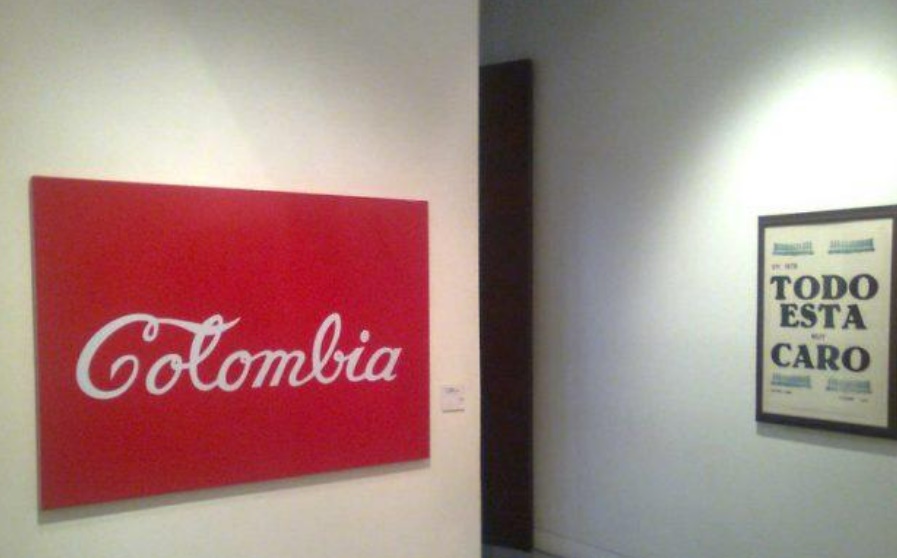
Antonio Caro
This artist is most famous for the protests expressed through his art. In 1977, he created his most recognizable work: a depiction of the Colombian flag, with letters spelling “Colombia” in the style of the Coca-Cola logo. As a “visual guerrilla”, Antonio Caro creates calls to rebellion and denunciations of corruption. He did this through public installations, posters, and paintings, all of which practically demand that viewers escape their inertia and take action.
Caro was actually inspired by the works of Doris Salcedo, and later worked with her and others to found the Colombian conceptual art movement. It was Salcedo who introduced Caro to the concept of text-based art, which would later lead to the creation of some of his most iconic works. Critics initially rejected Caro’s work, because of Caro’s own rejection of traditional artistic forms. However, the value of his projects soon became clear to critics in Colombia and beyond.
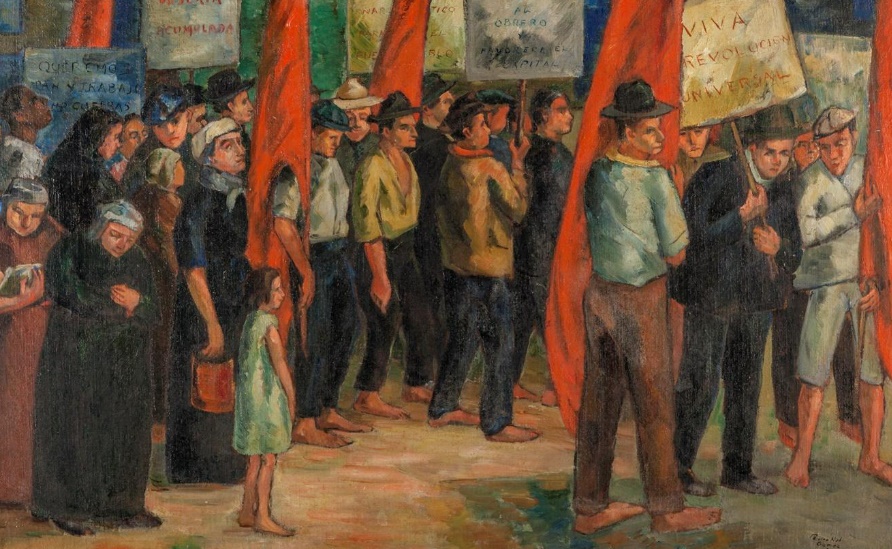
Pedro Nel Gomez
Gomez is primarily known for his murals, which typically depict social injustice, or imaginary societies that have found a medium between extreme poverty and wealth. However, he didn’t start his professional life as an artist; he actually studied and worked as a civil engineer for a few years before becoming serious about his art. As a civil engineer, he worked in the Antioquia region to inspect various infrastructure projects; the region’s natural beauty sparked his artistic imagination. What really set it on fire, though, was a visit to Florence where he saw Renaissance frescoes. From then on, he was dedicated to working as an artist rather than a civil engineer.
Gomez was deeply occupied with issues of social inequality within his home country, especially in the way it affected Colombia’s small farmers. While many of his murals had themes of injustice and protest, others expressed visions of egalitarian and cohesive societies.
When Pedro Nel Gomez passed away in 1984, one of his bequests included 2,000 square meters of murals, some of which were government-commissioned, and can still be seen today.
Fanny Sanín
This artist started out using an abstract gestural style that was similar to that of Joan Mitchell or Lee Krasner, but her artistic voice eventually developed to be more geometrical. Her most famous works are recognizable through their flat planes of color, which are hard-edged and symmetrical.
Sanín studied several different artistic endeavors as a student, including printmaking, theater set design, architectural drawing, and sculpture, but she decided that painting was her preferred medium fairly early on. This is what she believes gives her the greatest freedom to explore pure abstraction, without the burden of figurative representation. She wants to ensure that her only subject matter comes from form and color, and nothing else. Her artistic process is highly meditative and methodical, as she mixes her own colors and creates multiple preparatory studies.
Although she’s originally from Colombia, Sanín has spent much of her professional life living in London and New York City. Some of her greatest influences are Frank Stella, Kenneth Noland, Morris Louis, and Ellsworth Kelly.
Enrique Grau
Enrique Grau started pursuing art from a young age. Before he’d even graduated high school, he presented his early work Mulata Cartagenera to the First Salon de Artistas Colombianos, which earned him an honorable mention. Thanks to the positive attention this work gained, he soon got a scholarship to study in the US from the Colombian government. Although he still hadn’t graduated high school, he moved to the United States and started studying graphic art and painting at the Art Students League of New York.
Unlike many Colombian artists who depicted socioeconomic disparities, Grau came from a wealthy upper-class family. Even so, he was deeply troubled by the inequalities he saw in Colombia, and those themes marked his works. As a student, he also incorporated themes like racial struggles and lynching. He began exploring expressionism, and soon after surrealism and figurative abstraction.
Later Grau began exploring cubism, but he eventually returned to figurative painting, depicting characters that were baroque, humorous, heavy, and fantastical.
Edgar Negret
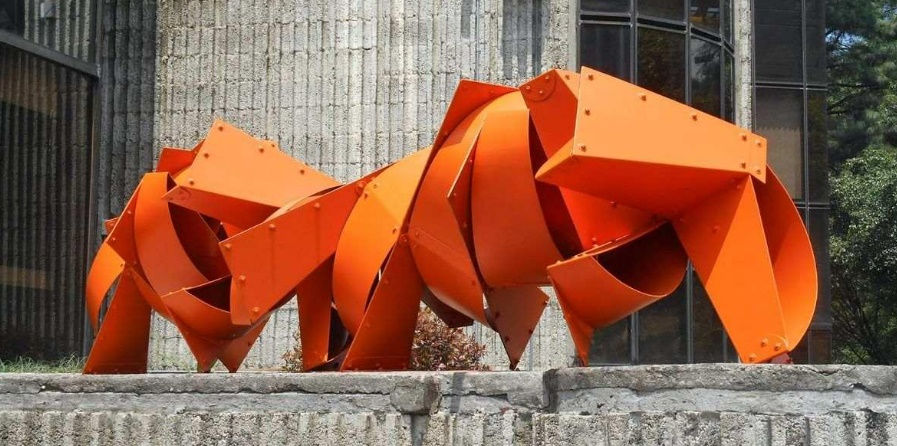
As a Geometric Abstraction Colombian sculptor, Edgar Negret worked mainly with metal. He’s known for a sculptural style that looks industrial, while depicting various aspects of nature. Originally born in Popayan, he later relocated to California in order to study at the Escuela de Bellas Artes. During this time, he got acquainted with a Spanish sculptor named Jorge de Oteiza, who happened to be living in Negret’s hometown at the time. Oteiza ended up becoming one of Negret’s earliest and strongest influences. Later, Negret would also take inspiration from the Modern Art movement that was blossoming in both the US and in Europe.
According to Edgar Negret’s artistic philosophy, when mechanical forms are freed from function, they become magical. He combined this with pre-Colombian symbolism in his later works, which paralleled a growing pride in indigenous Colombian culture in the later part of the 20th century. In 1985, his family’s home was converted to a museum; it’s still possible to see many of his decorative art items and sculptures in La Casa Museo Negret in Popayan.
Santiago Martinez
This artist stayed busy with a number of pursuits, most notably painting, sculpting, writing, and working as an art historian. He’s known for his murals, as well as for his woodcarvings, illustrations, oil paintings, and watercolors. Martinez began studying art at the young age of 11, at the Bogota Fine Arts Academy. At around age 20 he moved to Chicago to work at the Fine Arts Institute of Chicago, where he stayed for more than five years. Afterwards he returned to Colombia; by then his style had evolved to something similar to the pictorial Art Deco aesthetic, with an innovative touch in line pioneering. In addition to his purely artistic endeavors, he also illustrated and directed the primary outlet for Colombian cultural media Revista Vida.
The 40s and 50s are considered to be Martinez’s best years, winning various awards for his murals and frescoes. He was even honored by President Mariano Ospina Perez with the Cruz de Boyaca award. During this period, he also produced one of the best historical accounts of Simon Bolivar to be written, and is still considered to be one of the premier historians on this important figure to this day.
Pedro Ruiz
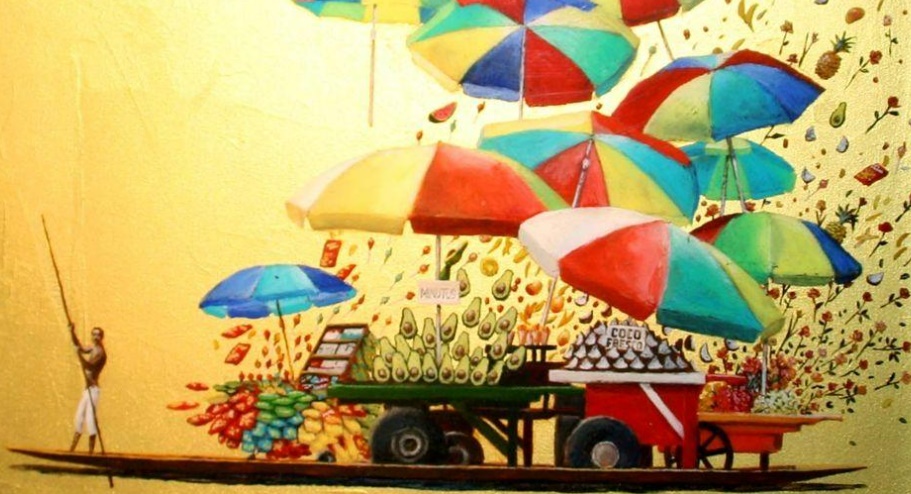
Through paintings and installations, Pedro Ruiz has developed four series: Colombianas Light, Gold, Displacements, and Love is in the Air. He has a strong commitment to turning every artistic message into a social project, believing in the importance of art that truly has an impact. He sees the harm that’s done by aggressive mining practices, heavy spraying on drug crops, social displacement, and the destruction of the natural world by multinational corporations. It deeply concerns him that these matters are affecting rural populations, and widening the disparity between them and urban residents. This disparity, and the urgency he feels surrounding it, occupy many of the themes of his works. Ruiz sees nature as a force that can’t be controlled; rather, it’s something with which everyone must live in harmony.
Pedro Ruiz is currently regarded as one of the most important artists in Colombia, and has been recognized as such by other countries as well. He’s an ambassador to UNICEF, and he’s also been given a knighthood with the Order of the Arts and Letters by the French government.
Debora Arango
As one of Colombia’s most influential and intense artists, Debora Arango challenged Colombian cultural norms with almost everything she did. Not only did she reject the future that her family wanted her to have as a middle-class Catholic, but she also defied the expectations of the Colombian government that artists wouldn’t touch certain subjects. During her career, she struggled against censorship and defamation because of the controversy of her work, particularly her portrayal of how certain classes of women were persecuted or forgotten. She also examined the hypocrisy of the Catholic Church, political corruption in the Colombian government, unexplored topics of sexuality, and the everyday struggles of vulnerable women in Colombia. Arango has been compared to Frida Kahlo, in the sense that she helped her home country adjust to the forces of modernization.
Arango’s earliest impact came from her paintings of female nudes. This might not sound controversial now, but in Colombia in 1939 it caused scandal throughout the country. These early works cemented her reputation as an unpredictable firebrand, mainly thanks to the conservative press who took every opportunity to condemn her. Not only was it unusual that a female artist would venture into this genre, but critics also seemed to dislike the portrayal of the female body through the eyes of another woman.
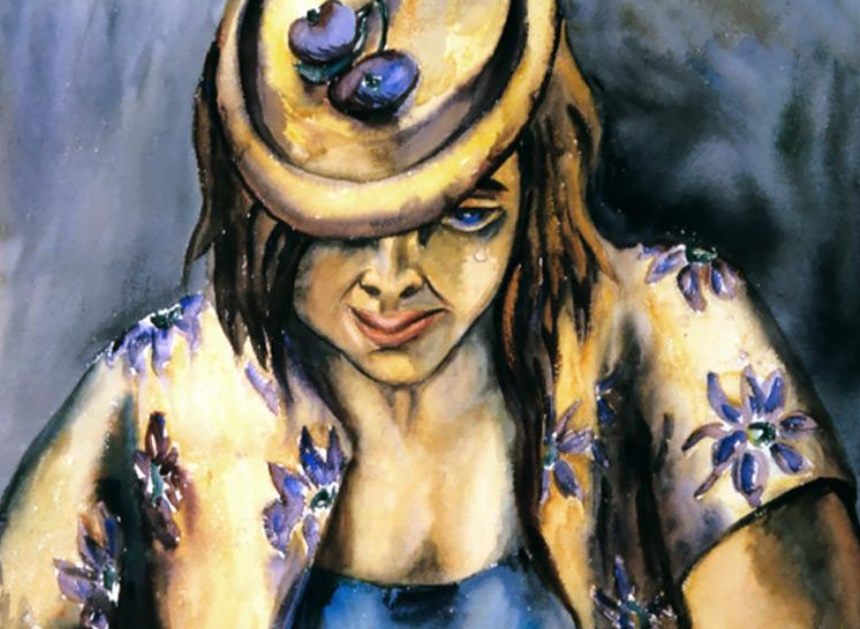
From the beginning of her career, Deborah Arango used every project to bring social issues to light. She had connections to the world of medicine through her brothers, and was allowed to visit prisons, asylums, and morgues to see first-hand how women were treated in these contexts. It was clear to her that the links between mental illness and incarceration were far too strong. She depicted this in works like Schizophrenia in jail, which features a frantic woman in a sparse jail cell, clearly struggling with her inner demons.
Arango also used art as a response to specific events, such as the period in Colombian history known as La Violencia. Her chaotic watercolors like The Train of Death and Massacre of the 9th of April marked a departure from earlier affirmations that she wouldn’t be bound by social responsibility. Instead, she felt obligated to respond to the Colombian’s government callous disregard for civilian lives. In The Train of Death, winding train cars are shown as being full of frozen bodies – something that actually happened as the government transported murdered citizens and detainees. The two works didn’t have the impact that Arango wished, though, because they were censored from public view by the Colombian government for two decades.
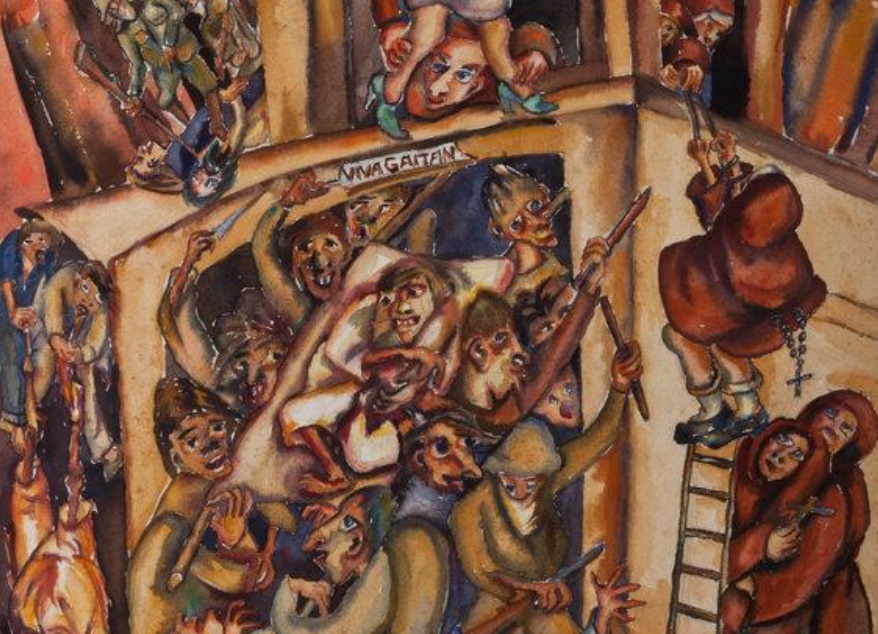
The social themes that Arango addressed also gained her the disapproval of the Catholic Church. She regularly depicted women in asylums, brothels, bars, and prisons. In one painting, a prostitute was being harassed by the police. In another, a female prisoner had to give birth unaided – and even more controversially, evoked the most important piece of Catholic iconography with the title Madonna of Silence. The scandal eventually grew to the point that the archbishop of her diocese threatened excommunication if she kept exhibiting her paintings.
Deborah Arango had a career that spanned eight decades, and every bit of it was satirical, transgressive, and innovative. She was a rule-breaker, even when it meant risks to her professional, religious, or personal life. Her legacy today isn’t just in her paintings, but also in the female Colombian artists who’ve continued to build on the foundation that she laid. Even though she never wanted fame during her lifetime, her life and works remain a key part of the history of Latin-American female artists.
From Medellin museum tours to art installations in London, Colombian artists have made their marks all over the world
Colombia hasn’t been known for its great modern art for long, partly due to the drawn-out civil war. Since then, though, more and more people have started to take notice of what this country has to offer. Some of these artists’ works can be viewed in European or US galleries, while others are integral parts of Medellin museum tours. Wherever you happen to see them, though, they’re certain to leave a powerful impression.
Disclosure: Some links on Medellin-Tours.com may earn us affiliate commission, at no cost to you. Affiliate links are a way for us to earn a commission if you purchase a tour we recommend through Viator for another provider.



